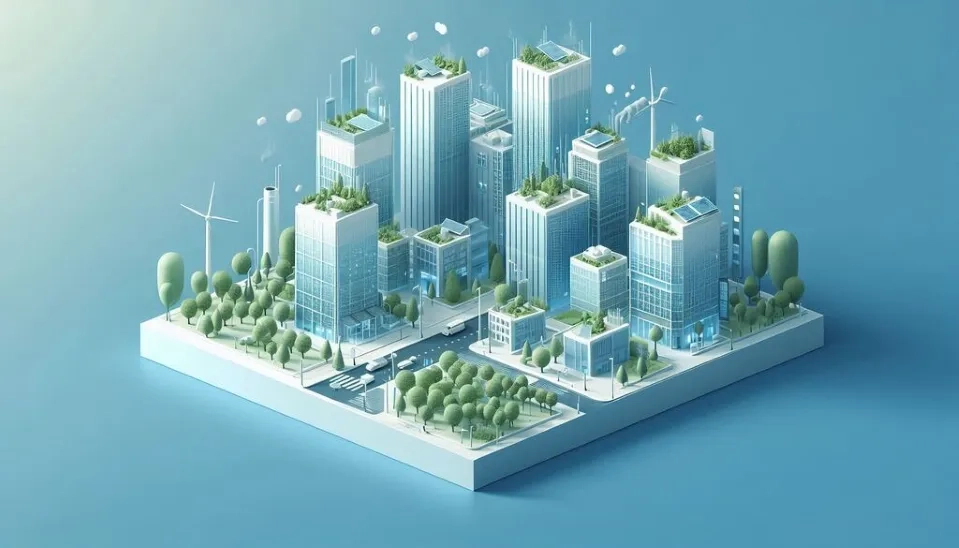
Did you know that cities across the U.S. experience temperatures up to 10℉ (5.6℃) higher than the surrounding landscapes, largely due to the urban heat island effects? (EPA, 2003). According to experimental analysis, implementing novel urban heat island solutions can significantly decrease the temperature by up to 2-3°C (3.6-5.3℉) and reduce cooling energy costs and health-related issues (Santamouris et al., 2019). The Urban Heat Island (UHI) is one of the most documented consequences of climate change and population growth in urban areas. This phenomenon occurs when the temperature in a metropolitan area considerably differs from that of the surrounding rural areas (Kolokotroni and Giridharen, 2008; Santamouris, 2007). The UHI effect can negatively impact the local economy, environment, and human health. These effects include high energy consumption, air pollution, reduced water quality and evaporation rates, and increased heat-related diseases (e.g., indigestion, depression, memory loss, etc.) (Irfeey et al., 2023; Rani, 2024). Thus, it is vital to take into consideration different urban heat island solutions. This article reviews 7 advanced and sustainable cooling technologies to mitigate the adverse effects of the urban heat island phenomenon.
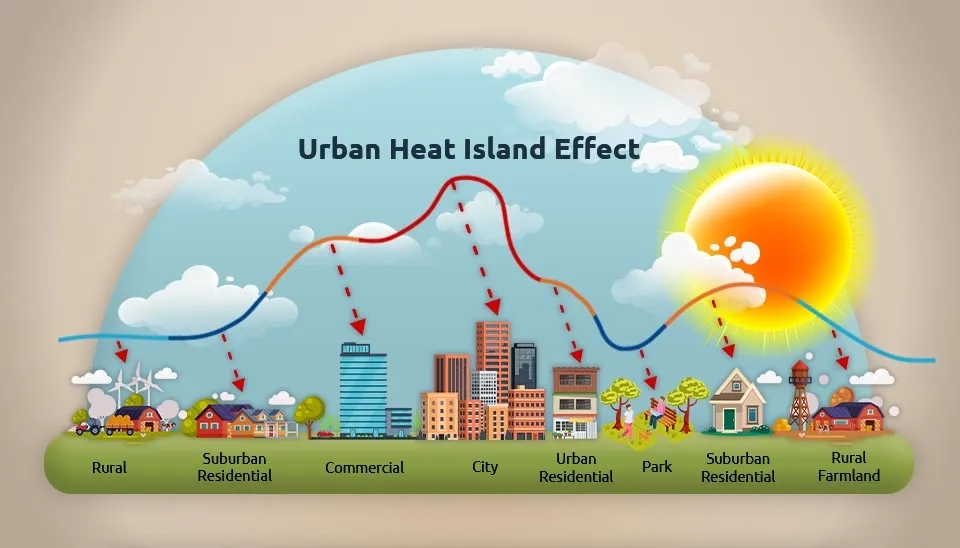
Table. 1. Urban roofs
UHI Cooling Strategy | |
Urban Green Spaces | Near-surface temperature reduction by 1-4.7°C (1.7-8.4℉) |
Green Roofs | Peak temperature reduction by up to 0.5℃ (0.9℉) |
Cool Roofs | Temperature reduction by about 12% Temperature reduction by 1.5℃ (2.7℉) |
Permeable and Cool Pavements | Reduction in surface radiative heat gain by about 18-20% |
Urban Structure and Building Designing | 60-90% reduction in CO2 emissions Heat reduction by about 25% |
Water Bodies and Stormwater Management Infrastructure | Surrounding temperature reduction by 2-6℃ (3.6-11℉) The average cooling effect of 1-3℃ (1.7-5.3℉) |
High Albedo Materials | 10-70% saving of cooling energy consumption UHI effect reduction by 1.5℃ (2.7℉) |
1. Urban Green Spaces
According to Shishegar (2014), the existence of different green spaces in urban areas, such as parks, street trees, shrubs, grasses, lawns, green walls, and other kinds of vegetation, can decrease the negative impacts of urban heat islands. Green areas can block short-wave solar radiation through absorption and reflection. Experts agree that adding green spaces in urban areas is the most effective cooling strategy for urban heat islands. Trees can mitigate the UHI effects in several ways: (1) by providing shade and reducing surface heat adsorption; (2) by decreasing the energy consumption that is wasted for cooling buildings in summer; (3) by maintaining changes in air temperature caused by building materials; and (4) through evapotranspiration (Gago et al., 2013; Rani, 2024).
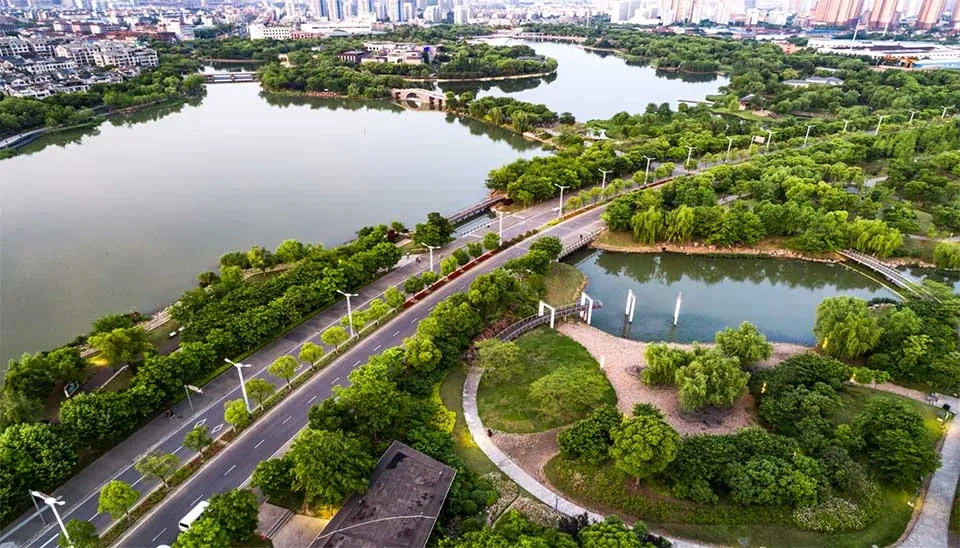
Plants and other vegetation can also provide shade, reduce air and noise pollution, and help keep the interior cool through thermal insulation (Roth, 2013). The results of some research indicate that green areas were cooler than areas with no vegetation cover (Givoni, 1991; Shishegar, 2014; Semenzato and Bortolini, 2023). Eliasson (1996) measured the mean air temperature difference between the city and parks (in Goteborg, Sweden), which was as high as 4°C (7°F). According to two studies conducted in the Netherlands and Singapour, green spaces reduce the near-surface temperature by 1-4.7°C (1.7-8.4℉), especially at nights with high UHI intensity (Kleerekoper et al., 2012; Li and Norford, 2012). Due to the numerous advantages that urban green areas offer, it is highly recommended to employ this strategy to mitigate the UHI effects.
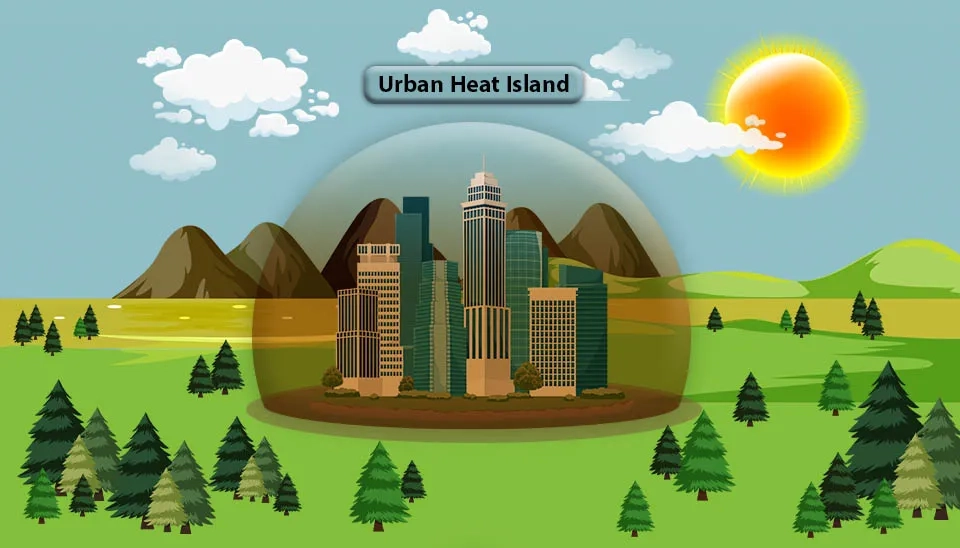
2. Green Roofs
Conventional building roofs with gray surfaces can contribute to the urban heat island effect in cities and may increase flooding risks. The implementation of green roofs is a viable strategy that could be used in houses, commercial buildings, and other constructions to reduce the impacts of UHI. Green roofs optimize the building's energy performance and improve the conditions of the surrounding environment (Gago et al., 2013). The study conducted by Hirano and Fujita (2012) in the Tokyo metropolitan area showed that in commercial buildings with green roofs, electricity consumption was reduced, leading to the mitigation of the UHI effect.

Green roofs offer multiple benefits, such as increasing evapotranspiration in urban areas, improving air quality, and reducing stormwater runoff (Yang et al., 2008; Li et al., 2014). Therefore, the conversion of grey roofs into green alternatives is not only a cooling strategy for UHI but also a feasible solution for stormwater management (Berndtsson, 2010). Green roofs can improve water retention by 7% and 10%, which also contributes to improvements in air quality and increases in biodiversity in urban areas (Susca et al., 2011; Leal Filho et al., 2017). According to a study conducted in Australia, green roofs could reduce the peak temperature by up to 0.5℃ (0.9℉) (Santamouris, 2019).
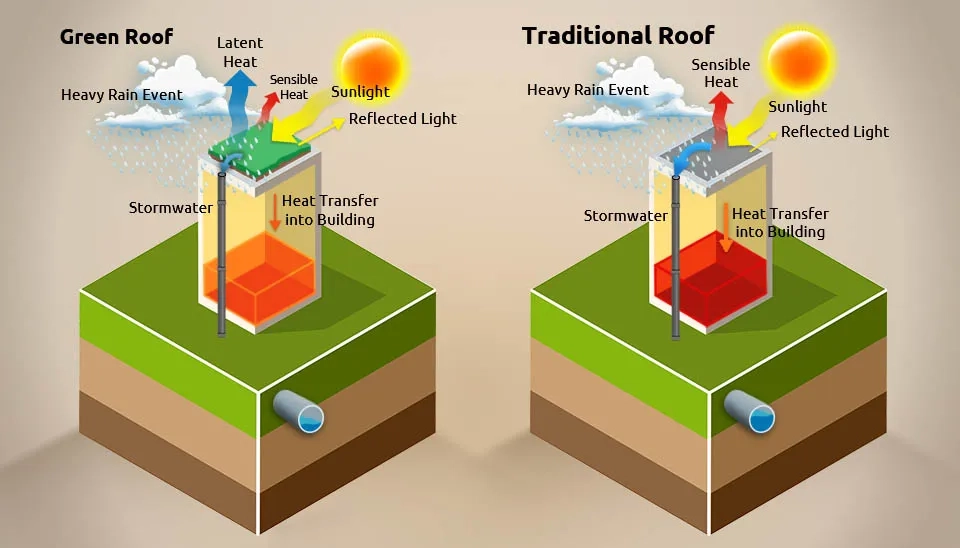
3. Cool Roofs
A cool roof can reflect a higher amount of solar radiation in urban areas through increasing the albedo of roof surfaces (Li et al., 2014). Selecting the proper roofing color (white and other light-colored surfaces) can contribute to temperature reduction by about 12%. In addition, roofing material with high albedo absorbs less solar heat and makes the building cooler, resulting in lower energy consumption (Nuruzzaman, 2015; Leal Filho et al., 2017). It was found that in Western Sydney, by implementing cool roofs, along with pavements and water technologies, higher reductions in temperature (1.5℃/2.7℉) were achieved in the area (Santamouris et al., 2019).

4. Permeable and Cool Pavements
To construct parking lots and sidewalks, many trees have been removed from cities. These trees no longer provide shade or help reduce temperatures, which has contributed to the formation of urban heat islands. Thus, it is necessary to develop green parking areas and green-covered sidewalks and also switch from asphalt-based parking spaces and sidewalks to reduce the UHI effect. These grass-covered spaces are known as permeable pavements. It is recommended to use different plant-growing materials, such as concrete, PVC, etc., to minimize the surface temperature of sidewalks and parking lots (Rani, 2024). Porous pavement systems can also be used for Urban Stormwater Management in urban areas by naturally allowing rainwater to penetrate the ground (Scholz and Grabowieckiet, 2007).
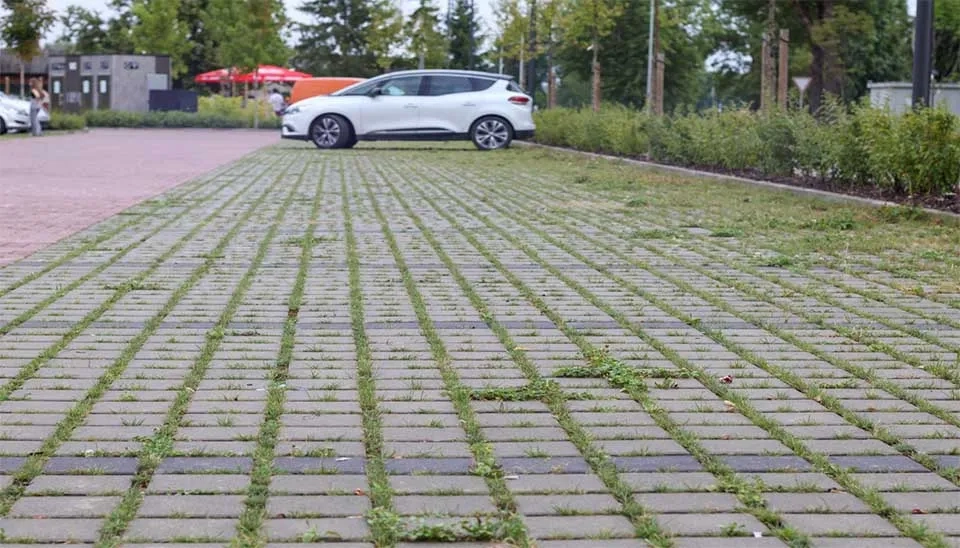
Using proper pavement material is also a key factor that affects the urban heat island effect. The differences in the albedo factor of finishing materials could alter the mean daily temperature. For example, dark-colored and rough materials absorb more solar radiation than light-colored and smooth surfaces (Doulos et al., 2004). It was found that by using proper materials, the surface radiative heat gain will be reduced by about 18-20% and the evaporative properties will be improved as well. Cool pavements can also lower the surface temperature and decrease sensible heat flux to the atmosphere (Roth, 2013; Leal Filho et al., 2017). Consequently, using permeable and cool pavements in urban areas is one of the cooling strategies for urban heat islands and could be applied in both sidewalks and parking areas to reduce the negative impacts of the UHI.
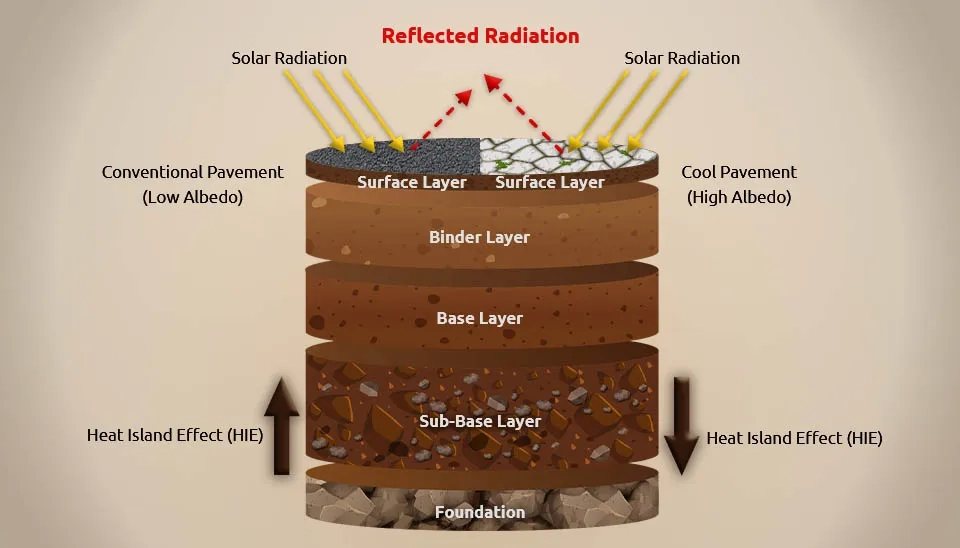
5. Urban Structure and Building Designing
The distribution and structure of buildings in urban areas could have an impact on the formation of the urban heat island. In fact, the distribution of buildings could determine the absorption of solar energy and change wind streams. Therefore, efficient and adequate building orientation can significantly reduce the UHI effects and increase cooling energy efficiency (Gago et al., 2013; Rani, 2024). In the USA, with an increase of 10% in spatial contiguity, the average UHI intensity was improved by between 0.3-0.4℃ (0.5-0.7℉) (Debbage and Shepherd, 2015). A study conducted by Yamaguchi et al. (2007)in Osaka, Japan, showed that about 60-90% of the CO2 emissions could be reduced with optimal and sustainable building design and using low energy-consuming materials (Futcher et al., 2013). In California, by increasing high-albedo materials in the city from 25 to 40%, the temperature was reduced by 1-4℃ (1.7-7℉). In addition, by increasing the albedo from 9 to 70%, a 19% reduction in annual cooling demand was achieved. Overall, experiments showed that by increasing both the city-wide albedo and building albedo, a reduction of 62% in cooling energy demand could be achieved (Taha et al.,1988; Kleerekoper et al., 2012).
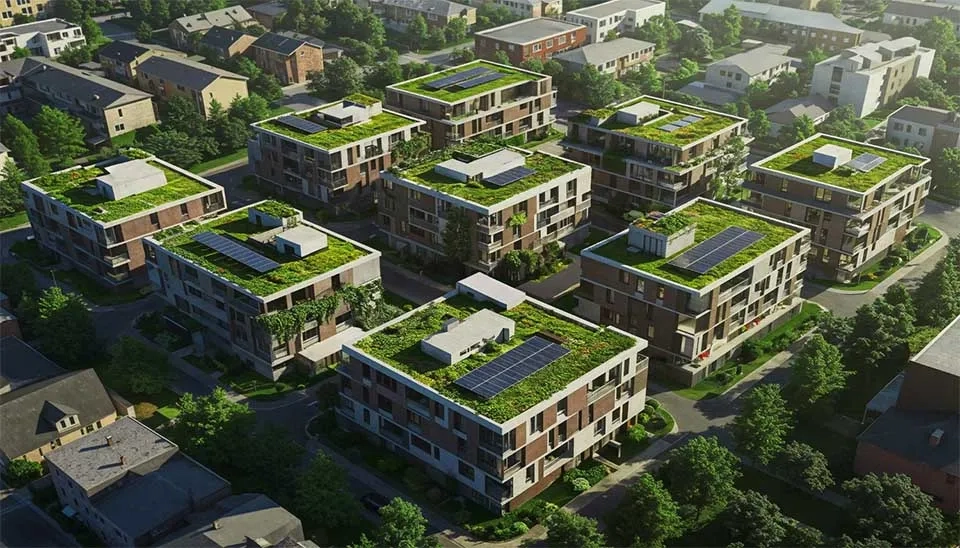
Furthermore, by properly applying advanced techniques in urban design, such as Green Infrastructure (GI) (shaded areas, urban greenery, water features, pavement, etc.) and using sustainable materials (reflective materials, evaporative systems, light-colored paint, phase-change materials, fluorescence, etc.), the ambient temperature could be reduced and the urban heat island effects could be mitigated (Santamouris, 2007; Irfeey et al., 2023; Rani, 2024).
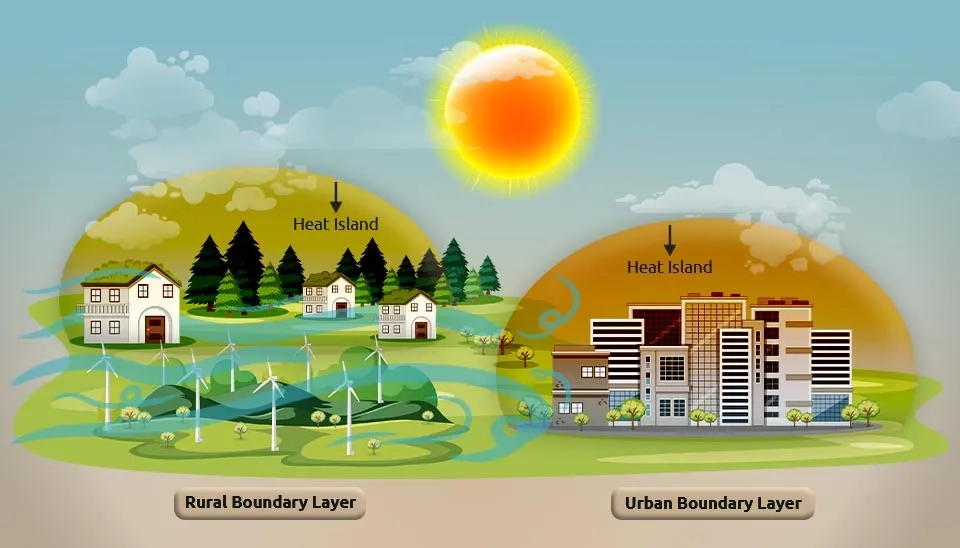
6. Water Bodies and Stormwater Management Infrastructure
The urban heat island could have an adverse impact on the hydrological cycle, as it could affect the evaporation and water runoff rates. Urban areas with impermeable surfaces may face stormwater runoff and urban flooding. Additionally, the quality of water bodies in cities may be influenced by changes in temperature. Therefore, it is crucial to use sustainable urban heat island solutions. One effective solution is installing water bodies, such as rivers, lakes, ponds, infiltration trenches, wells, etc. that produce a cooling microclimate through evaporation and provide cooling effects in urban areas (Rani, 2024).

Since the evaporation of the water absorbs heat, water bodies can be regarded as heat sinks in the urban landscape and are effective in reducing the surrounding temperature by 2-6℃ (3.6-11℉) (Rani, 2024). In another study, it was found that water has an average cooling effect of 1-3℃ (1.7-5.3℉) in Dutch cities (Kleerekoper et al., 2012). The effectiveness of this strategy to reduce the temperature depends on the size, shape, climatic conditions, surrounding land use, and vegetation cover. The integration of water bodies with urban green spaces will optimize cooling efficiency through increased shading and evapotranspiration. This can effectively and sustainably reduce the UHI adverse effects in urban areas (Jandaghian and Colombo, 2024).
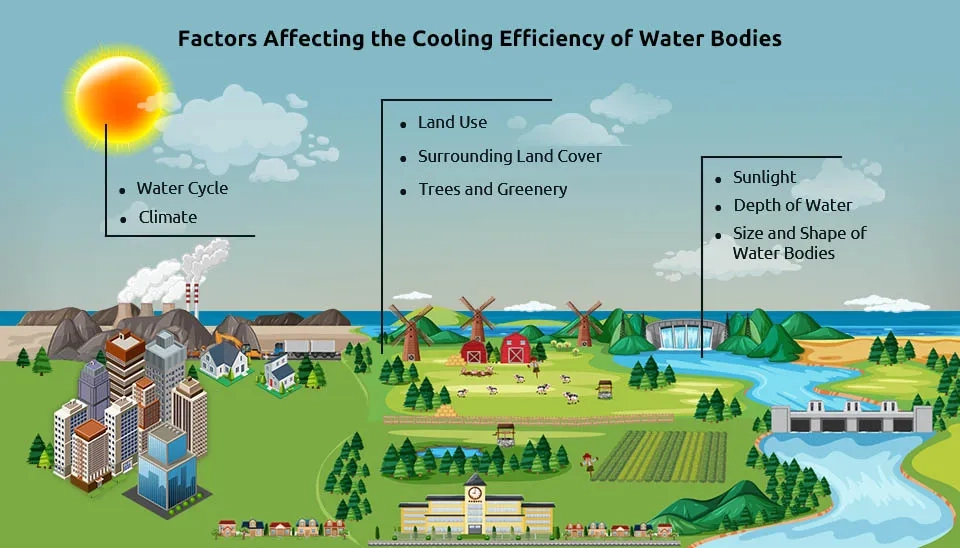
7. High Albedo Materials
The color of the roof can affect the home temperature. Low-albedo materials absorb solar heat, requiring more energy to cool the home with air conditioning systems. Using roofing materials with high albedo ratings like white or light-colored roof coatings (acrylic, elastomeric) and reflective metal roofs (Aluminum, galvanized steel) is one of the effective mitigation strategies for urban heat island effects (Rani, 2024). Furthermore, the building's structure, form, and position are important factors affecting the efficiency of using high-albedo materials. A study conducted by Bretz and Akbari (1997) demonstrated that after applying high albedo coatings to residential buildings in California and Florida, it was possible to save about 10-70% of cooling energy consumption. In the Dutch city centers, it was found that increasing albedo in roof surfaces achieved a UHI effect reduction by 1.5℃ (2.7℉) (Icaza et al., 2019).
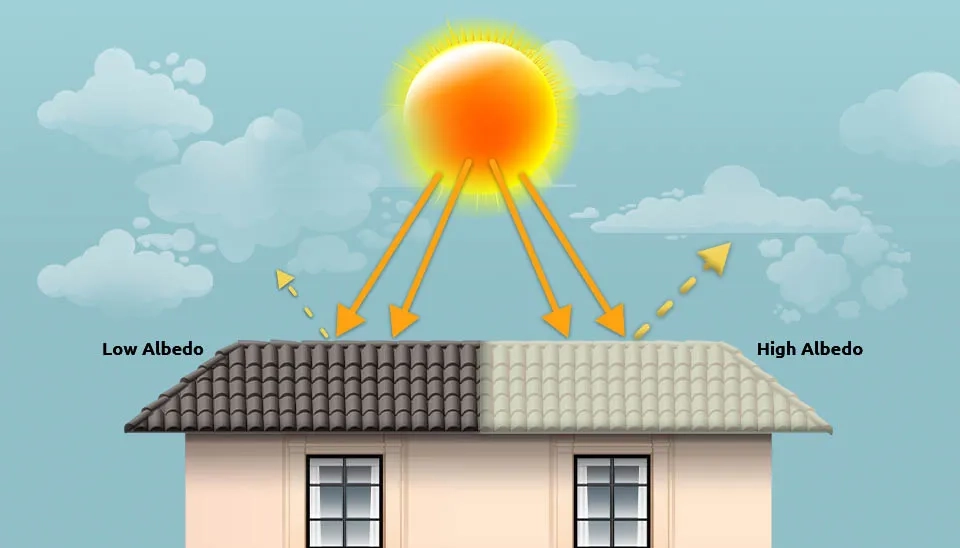
Replacement of tarmac with materials that do not keep heat will decrease the UHI effects in the city (Carnielo and Zinzi, 2013). For example, in Lyric Square of London, light-colored brick was used on street surfaces instead of black tarmac, since light-colored materials have a higher albedo rating. As a result, it was found that this replacement is a successful attempt to reduce the negative impacts of UHI (O’Malley et al., 2015).
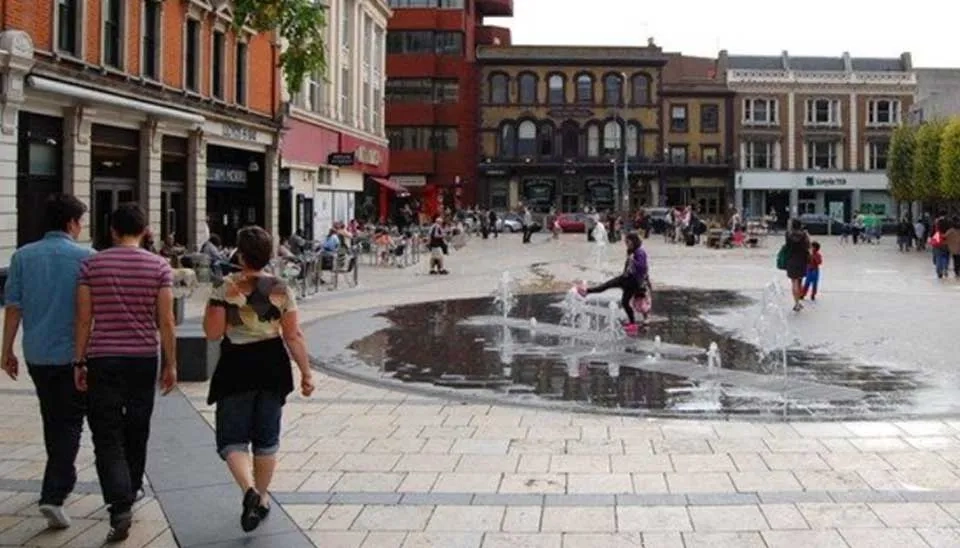
Raising Public Awareness
Apart from the technical urban heat island solutions mentioned in this article, governments should consider the urban residents’ comfort and implement measures to minimize the negative impacts of heat. The U.S. EPA has provided guidelines to facilitate the development plans that governments should employ to reduce UHI effects. Some of the main strategies are forecasting and monitoring, education and public awareness, and heat wave response. Weather and climate predictions allow urban officials to inform urban residents about heat waves, helping them to be better prepared. Public awareness through education helps citizens learn about the adverse impacts of increased temperature and know potential risks, heat-related diseases, and proper treatment (EPA, 2015). Communities and urban residents should all contribute to the implementation of different cooling and mitigation strategies to minimize the urban heat island effects (Leal Filho et al., 2017).
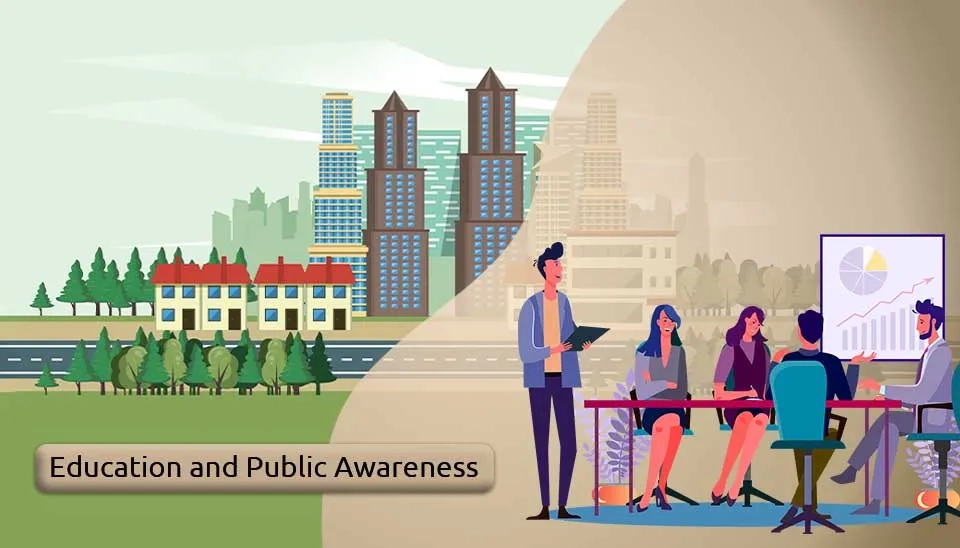
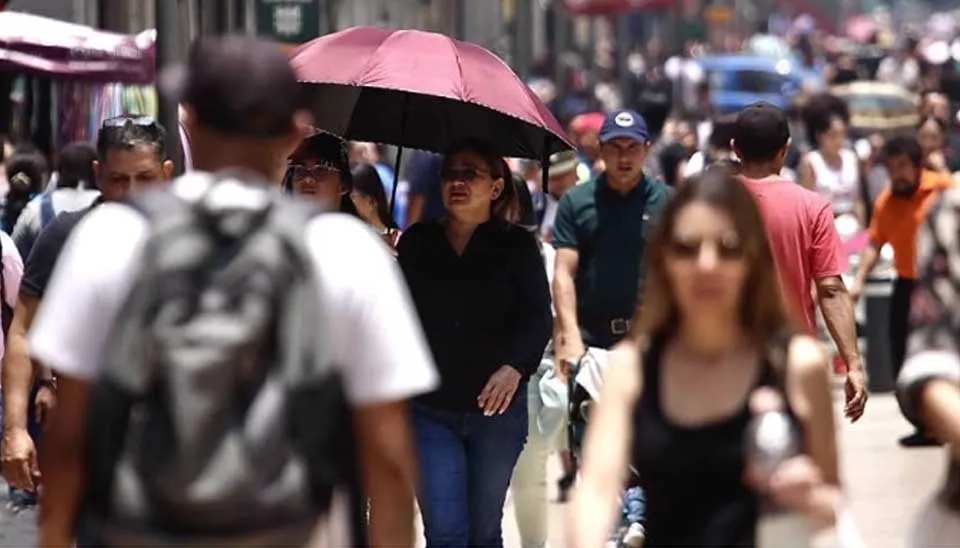
Conclusion
Under certain circumstances, the heat from solar radiation can make air temperatures rise in urban areas. The urban heat island effect can be minimized through the implementation of sustainable cooling strategies. Some of the main mitigation strategies for urban heat islands were introduced in this article. The use of green spaces, such as parks and trees in the urban landscape, the use of green and cool roofs in urban buildings, the use of permeable pavements in streets and parking lots, the use of high albedo and cool materials in urban structures, adequate and optimal building design, the presence of water bodies, such as rivers and ponds within a city, and education and raising public awareness are the main urban heat island solutions. By integrating different urban cooling strategies, cities can effectively mitigate the UHI effects, resulting in more sustainable urban areas along with enhanced economic growth. Decision makers, architects, urban planners, city authorities, and the general public can all contribute to counterbalancing the urban heat island effect.
